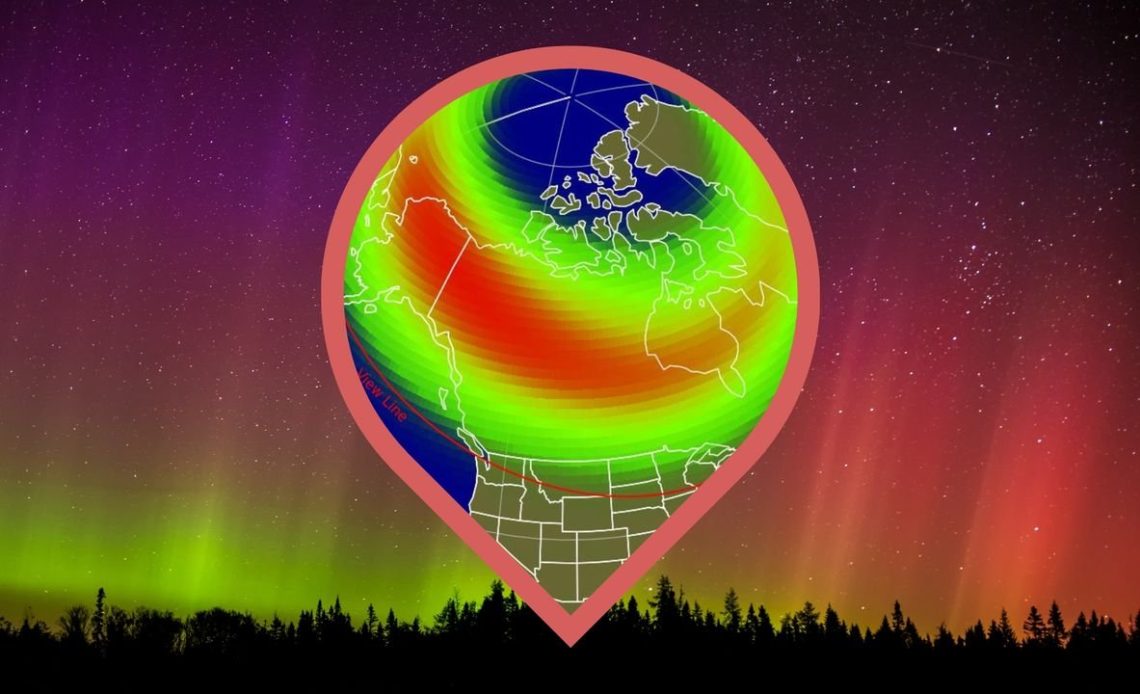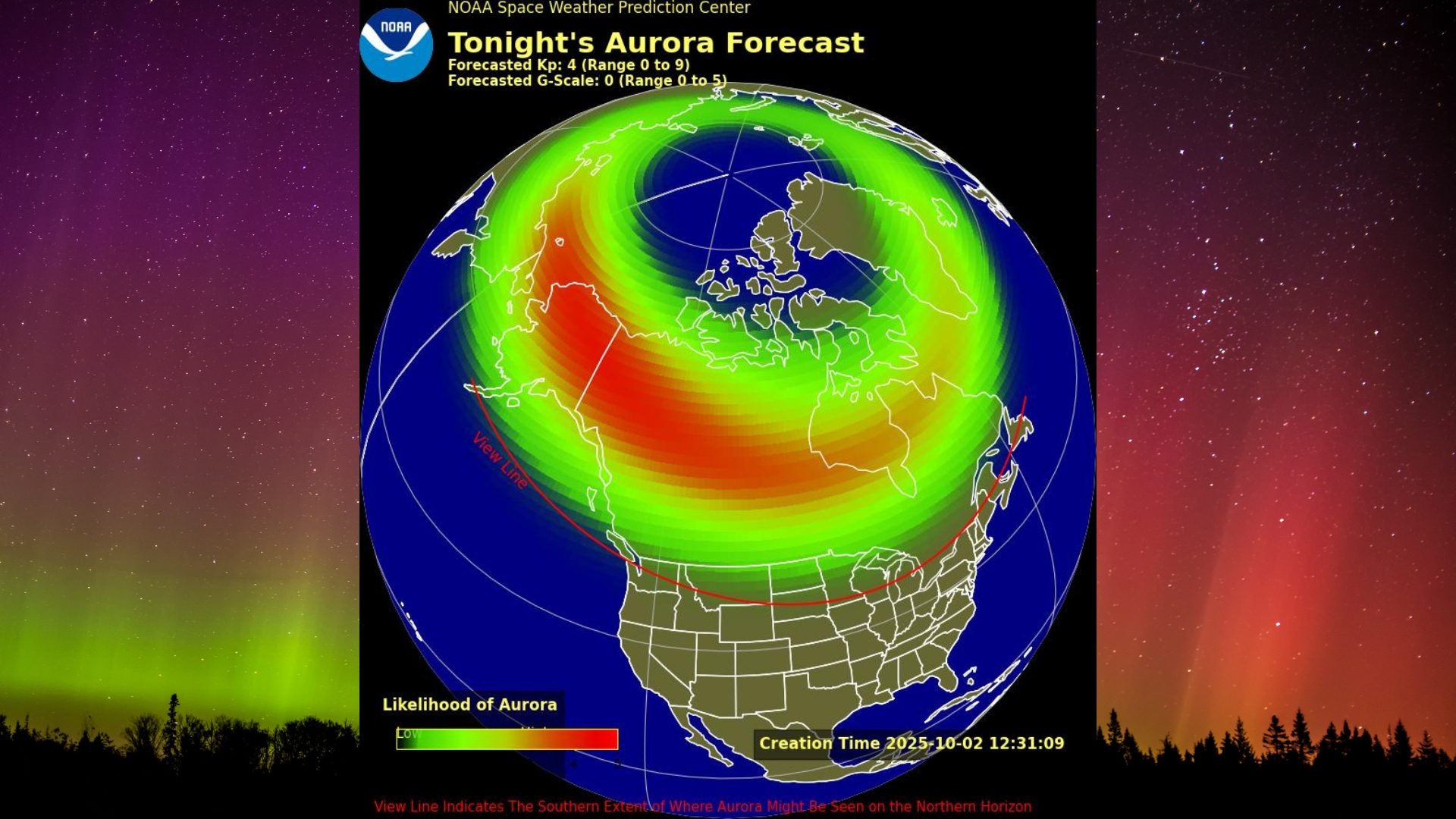
Aurora watchers: don’t pack up your cameras just yet, as the northern lights may return for one last dazzling display tonight (Oct. 2) before conditions quiet down again over the weekend.
Over the past few nights, geomagnetic activity has repeatedly exceeded expectations, with a rather surprising G3 (strong) geomagnetic storm lighting up skies as far south as New York on Wednesday night (Oct. 1). Now, forecasters at NOAA’s Space Weather Prediction Center (SWPC) say the show isn’t quite over yet. A G2 (moderate) geomagnetic storm watch remains in effect for tonight, as high-speed solar wind continues to buffet Earth’s magnetic field.
“G3 (Strong) geomagnetic storm activity was observed on 02 October at 0559 UTC.” NOAA’s SWPC reports. “Similar conditions are expected to continue through 02/1200 UTC with G1-G2 (Minor-Moderate) storm levels being likely thereafter.”
When and where can you see the northern lights tonight?
NOAA’s latest 3-day Kp index forecast shows that geomagnetic activity could reach G1 (minor) storm levels for much of today (Oct. 2), with a potential G2 (moderate) peak between 9 a.m. and 12 p.m. GMT (5 a.m. to 8 a.m. EDT). Although this peak occurs during daylight for many aurora chasers, activity is expected to remain elevated throughout the day and into the evening hours, offering a decent chance for northern lights sightings after dark — especially if the storm strength holds or intensifies as it has on previous nights.
If G2 conditions materialize, the aurora could once again be visible across a wide swath of the northern U.S., weather permitting. Based on NOAA’s latest aurora oval forecast, the following states appear to be at least partially above or extremely close to the aurora view line tonight.

States that could see the northern lights tonight
- Alaska
- Washington
- Idaho
- Montana
- North Dakota
- South Dakota
- Minnesota
- Wisconsin
- Michigan
- New York
- Maine
- Wyoming
Auroras are highly unpredictable, and if G2 or even G3 geomagnetic storm levels are reached — as they were on previous nights — the auroral oval could expand farther south to include additional states like Vermont, and possibly parts of northern Pennsylvania, Iowa, or Oregon’s southern half under the right conditions.
Northern Hemisphere aurora forecast courtesy of the Met Office
Will the auroras continue into the weekend?
Unfortunately, this may be the last night of significant aurora activity from this particular space weather event. Both NOAA and the U.K. Met Office expect geomagnetic conditions to gradually settle after Oct. 2, as solar wind speeds begin to decline and Earth moves out of the most active part of the solar wind stream.
There may still be occasional active periods into Oct. 3, but the chance of G1 or stronger storms will diminish.
How to see the northern lights where you live
If you’re in one of the 12 U.S. states listed above, here are some tips for catching the display:
- Head to a dark location far from city lights.
- Find a north-facing view with a clear horizon.
- Look up around midnight to 2 a.m. local time, but keep watch as soon as skies darken.
- Be patient. Auroras often come in waves and can appear faint at first.
We recommend downloading a space weather app that provides aurora forecasts based on your location. One option I use is “My Aurora Forecast & Alerts,” available for both iOS and Android. However, any similar app should work well. I also use the “Space Weather Live” app, which is available on iOS and Android, to get a deeper understanding of whether the current space weather conditions are favorable for aurora sightings.
What’s causing the aurora activity?
This ongoing bout of geomagnetic unrest is being driven by a stream of fast solar wind flowing from a positive polarity coronal hole, a region of open magnetic field lines on the sun that allows solar particles to escape into space. These high-speed solar winds have been blasting Earth at speeds exceeding 800 km/s (1.8 million mph), stirring up Earth’s magnetic field and creating ideal conditions for auroras.
What’s more, Earth’s current connection to this coronal hole is especially strong due to the equinox, known as the Russell-McPherson Effect. This seasonal alignment makes the planet’s magnetic field more sensitive to solar disturbances around the spring and fall equinoxes.
According to NOAA, solar wind conditions remain “elevated and disturbed,” with the magnetic field orientation (known as Bz) frequently dipping southward — a key ingredient for energizing geomagnetic storms and producing visible auroras.
Author: Daisy Dobrijevic
Source: Space.com
Reviewed By: Editorial Team



